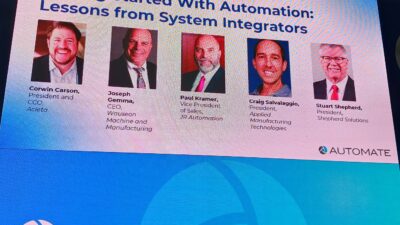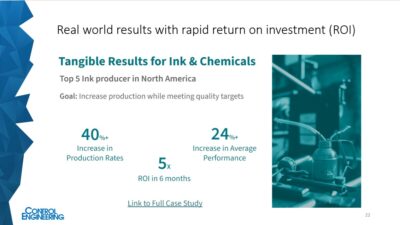A little more pay. A lot more stress. Control and automation engineers and technical professionals are collectively receiving slightly higher salaries than three years ago, but almost all are coping with wrenching organizational andtechnological changes in their companies and disciplines, according to 686 respondents to Control Engineering's North American Reader Profile Study, June 2000.
|
A little more pay. A lot more stress. Control and automation engineers and technical professionals are collectively receiving slightly higher salaries than three years ago, but almost all are coping with wrenching organizational and technological changes in their companies and disciplines, according to 686 respondents to Control Engineering ‘s North American Reader Profile Study, June 2000.
In the survey’s most dizzying example of this upheaval, almost 97.6% of 246 respondents say they and/or their organizations have been through a major merger or acquisition in the past three years. Of these, a slight majority (54%) felt their merger was handled well, while less than half (44.5%) believe adequate thought was given to the best way to integrate the people, jobs, work teams, and cultures affected by the merger. Also, more than 64% agree their merger or acquisition was primarily financially motivated.
Disillusionment isn’t endemic-key attributes rank above money. When asked what were the most important attractions of their jobs 681 respondents, placed ‘technical challenge,’ (48%), ‘feeling of accomplishment’ (42.7%), and ‘good relationship with colleagues’ (28.3%) ahead of ‘money’ (27.3%). And, giving voice to their hunger for long-term-focused leadership, these respondents also reported they are more concerned about ‘keeping current on technology’ (51%) and ‘management support’ (40.7%) than they are about ‘job security’ (32.8%).
When asked how mergers, acquisitions, and reorganizations could be made more successful in the long run, survey respondents added more than 100 written suggestions. Many stressed the need for better leadership; more frequent and truthful communications between management and staff; and improved integration plans that evaluate technical compatibility, address cultural issues, and cross train new colleagues on each other’s development methods. They advised decision-makers to investigate, listen to employees, make sure they’re genuinely informed before and during a merger, and communicate clear expectations. They emphasized that mergers should focus on long-term growth of the business, its customers, and employees, and not just on short-term profits. [For more on merger management and creating new work teams, see September 2000’s ‘Career Update’]
Outlining the individual
Besides scaling allegorical peaks, professionals responding to the survey work in numerous engineering fields. These include: 16.8% product design; 14.9% process or manufacturing production; 13.5% control or instrument engineering; 12.4% project, software, plant, and electrical/electronic engineering; 11.4% system design; 10.8% operations/maintenance; 9.1% general/corporate management; 4.2% evaluation/quality control/standards/reliability/test; 2.8% systems integration; and others.
Speaking through the study’s survey, these 686 respondents report they’re 46.2 years old on average and 97% male as a group. That’s about a year younger and almost the same gender mix compared to Control Engineering ‘s readers polled in 1997. Close to two-thirds of this year’s respondents are in two age groups-32% are in the 35-44-year-old group and 31% are in the 45-54-year-old group.
A bachelor’s degree, mostly in electrical or mechanical engineering, was the highest education level reached by half (48%) of the respondents. Meanwhile, 8% attended graduate school and 20% earned advanced degrees, again, mostly in electrical and mechanical engineering. More engineers had electrical engineering (46.1%) and mechanical engineering (21.5%) degrees in 2000 than those surveyed previously, who had 45.6% electrical engineering and 15.5% mechanical engineering degrees in 1997. All other specific bachelor’s degree categories declined from 1997 to 2000, except for computer programming, which increased to 2.4% from 1.6%.
The respondents report gross wages averaging $71,510 in 2000. This might seem to be a significant increase over the $64,000 average earned by 1997’s respondents. However, it amounts to slightly less than raises of 4% per year, which roughly parallels U.S. inflation in recent years and is less than cost-of-living increases in many areas.
Half the engineers surveyed were in the $50,000-$79,000 gross income range. Those earning $60,000-$69,000 made up the largest (20%) income group segment. About 11% of respondents earned more than $100,000 per year. Less than half (43%) secure some income from commissions and bonuses.
In general, there were slightly fewer respondents in the 2000 study’s income segments below $70,000 than in 1997, while there were more current respondents in the $70,000-$100,000 and above segments than previously.
Consistently a veteran population, Control Engineering ‘s readers in 2000 average 21 years of work experience and 12.6 years with their present employers. Respectively, this was slightly less than the 1997 group’s 23-year average experience and slightly more than its nine-year average tenure. In fact, the 2000 survey’s largest work experience group (20%) included engineers with more than 31 years of experience, while 12% have worked for their current employer for more than 25 years.
This year’s respondents have an average of 9.4 staffers reporting to them, up from five direct reports to 1997’s respondents.
Besides these responsibilities, more evidence of the pressure engineering professionals face is demonstrated by the hours they work. The 2000 survey’s respondents average 47 hours per week with more than 25% working 46-50 hours, 8.3% working 51-55 hours, and 11.3% working 56 hours or more.
Most Important Aspects of Present Job
(Top two attractions chosen by 681 respondents)
| Technical challenge | 48.0% |
| Feeling of accomplishment | 42.7% |
| Good relationship with colleagues | 28.3% |
| Money | 27.3% |
| Job security | 24.7% |
| Pleasant work environment | 16.4% |
| Chance to be a team leader | 6.2% |
| Other | 4.1% |
Biggest Concerns in Present Job
(Top two concerns chosen by 673 respondents)
| Keeping current on technology | 51.1% |
| Management support | 40.7% |
| Job security | 32.8% |
| Sufficient operating budget | 25.1% |
| Company merger or acquisition | 17.1% |
| Keeping current on regulations | 12.9% |
| Outsourcing/privatization | 10.1% |
| Other | 5.5% |
Companies and spending
While engineering professionals climb over obstacles in diverse fields, their employers likewise do business in an equally wide range of industries. Survey respondents say their companies are involved in: raw materials processing (28.3%); machinery and equipment manufacturing (22.1%); instrumentation and control manufacturing (10%); fabricated metal manufacturing (9.1%); automotive or transportation equipment (6.1%); utility services (4.5%); aircraft, missile, or ordnance manufacturing (3.8%); and others.
A total of 583 respondents report that annual sales for their employers range widely, but also are evenly spread among the survey’s sales group segments from less than $1 million to more than $1 billion. Twenty-five respondents (4.3%) say their companies’ sales are less than $1 million, while 146 respondents (24.9%) report their companies’ sales are $1 billion or more per year. This is the largest sales group segment. The only other annual sales segments containing double-digit percentages of respondents were $1-4.9 million (10.2%); $10-24.9 million (13.1%); and $25-49.9 million (10.6%).
To help generate sales, these companies spent thousands to millions of dollars on controls, automation, and instrumentation products and services, replacement equipment, and repairs. Based on 1999’s expenditures, more than 74% of respondents expect to spend more or as much over the next two years; 29.6% of 648 respondents estimate their companies will increase spending; 44.6% project expenditures will remain about the same; 4% say spending will decrease; and 21.8% were uncertain.
The $100,000-$200,000 spending segment included 13.5% of 2000’s companies, up from 10.9% in 1997. On the high and low ends, 20.3% of respondents’ employers spent less than $30,000; 10.3% spent $30,000-$50,000; and 9.2% spent $3 million or more in 2000.
While most funds went to products and repairs, 78% of 481 respondents in 2000 reported that up to 30% of their firms’ expenditures were spent on services. Likewise, they added that 60.1% of their companies work with integrators and consultants on automation projects.
Work Experience
(681 responses in 2000, averaging 21 years)
| 2000 | 1997 | |
| 5 years or less | 7.6% | 6.1% |
| 6-10 years | 10.9% | 7.8% |
| 11-15 | 12.9% | 11.3% |
| 16-20 | 15.6% | 16.9% |
| 21-25 | 18.4% | 15.6% |
| 26-30 | 13.5% | 16.5% |
| 31 or more | 21.1% | 26.0% |
Years with Present Employer
(681 responses in 2000, averaging 12.62 years)
| 2000 | 1997 | |
| 2 years or less | 11.7% | 13.6% |
| 3-4 years | 14.1% | 12.2% |
| 5-6 years | 9.5% | 11.8% |
| 7-9 years | 9.4% | 13.5% |
| 10-15 years | 23.2% | 13.11% |
| 16-20 years | 11.3% | 11.8% |
| 21-25 years | 8.7% | 11.8% (21-28 years) |
| 26-30 years | 7.2% | (see above) |
| more than 30 years | 4.8% | 12.1% (29 or more years) |
Control Engineering Typical Reader
The average reader is still overwhelmingly male, a bit younger, slightly better paid, still very experienced, has a couple more years with his current employer, and has a more direct reports.
| 2000 | 1997 | |
| Age | 46.2 | 47 |
| Degree | Electric engineering | Electrical engineering |
| Annual salary | $71,510 | $64,000 |
| Total work experience | 21 years | 23 years |
| Present tenure | 12.6 years | 9 years |
| Direct reports | 9.4 staffers | 5 staffers |
Information, the Internet
Just as mountaineers need ropes, crampons, and harnesses to safely reach the summit, engineering professionals rely on traditional and new tools to help their companies compete and survive. Useful information helps engineers make the most of their organizations’ resources, for instance, and survey respondents secure the data they need from many sources.
Trade magazines and trade magazine advertising are still the most used information sources. However, the Internet is quickly catching up.
Of 644 respondents in 2000, trade magazines’ print editions were used by 78% and advertising in trade magazines’ print editions was used by 77.5%. Jumping to third from ninth place, however, the Internet was accessed by 71.3% of respondents in 2000, more than double the 34.5% that accessed it in 1997.
Meanwhile, other traditional information sources also lost ground while the Internet soared. Respondents using sales visits declined to 54% in 2000 from 62.9% in 1997; tradeshow visits dropped to 50.8% in 2000 from 62.9% in 1997; seminar attendance declined to 39.4% in 2000 from 45.9% in 1997; and direct mail decreased to 39.4% in 2000 from 49.8% in 1997.
In addition, 24.3% of respondents identified the Internet as their most important data source. This was followed by trade magazine advertising (23.4%), trade magazine articles (18.3%), sales visits (13.7%), specific web sites (5.3%), as well as 4% or less for tradeshows, direct mail, e-mail, seminars, general business publications, and CD-ROM or software demos.
Respondents use Control Engineering ‘s own web site ( www.controleng.com ) to learn about new products (63.6%), news (38.8%), tutorials (36.4%), magazine issues (26.4%), media information (24%), trade shows and events (22.5%), directories (16.3%), web exclusives (7.8%), and technology channels (4.7%).
On the print side, nearly 70% read all or most Control Engineering issues; 28% of the respondents reported reading every issue, 41.5% read most issues, and 29.3% read some issues. They add that 28.2% have received Control Engineering for less than two years, 43% have read the magazine for 2-5 years, 17.8% have received it for 6-10 years, and 11% have read it for more than 10 years.
Given the ongoing competitive and technological tumult in control and automation and their related industries, Control Engineering ‘s readers and their companies will no doubt continue to combine all the useful data they can find with their traditional hard work and innovative fire. They also may use one well-known piece of rock climbing advice: don’t look down.
Objectives and Methodology
The aim of Control Engineering’s North American Reader Profile Survey, June 2000, was to investigate readers’ educational background, compensation, and work experience; examine their employers’ sales and expenditures for instrumentation, control, and automation products and services; determine readers’ information requirements, both in print and online; and investigate reading habits.
To fulfill these objectives, Control Engineering and Cahners Research conducted a mail survey by sending 3,000 six-page questionnaires on April 18, 2000, to a sample of 3,000 of the magazine’s readers. A total of 686 qualified replies were received by June 19, 2000, for an overall response rate of 23%.



